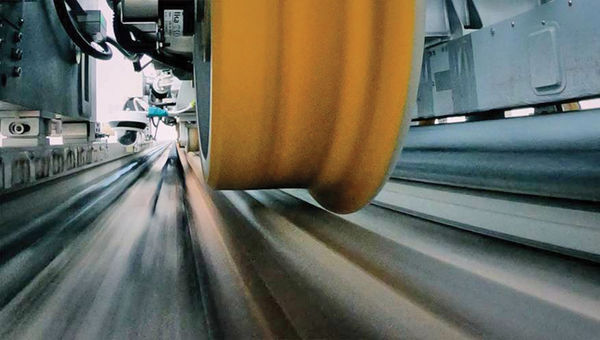The Polish startup Nevomo has developed a technology that can adapt traditional railroads to support electrified, high-speed travel while still accommodating traditional trains.
Nevomo successfully tested its MagRail system over a series of several months this year along a 0.45-mile track in Nowa Sarzyna, Poland.
MagRail uses magnetic levitation -- similar to hyperloop systems, except without the vacuum-sealed tubes -- to propel train cars forward without the friction of conventional rail.
An electrified motor within the undercarriage, or bogie, of each car enables individual cars to be powered to move free of locomotives, adding operational flexibility.
"It's a tubeless hyperloop on legacy infrastructure," said Stefan Kirch, Nevomo's chief business development officer.
Nevomo said MagRail cars will be able to travel at up to 187 mph along standard railroad lines and even faster where high-speed rail lines exist. Adapting those lines to support MagRail would cost between one-third and one-half the price of building new high-speed track, Kirch said. In the U.S., where just 1% of the nearly 140,000 miles of railroad track runs off of electric propulsion, such upgrades would also have the secondary benefit of decarbonization.
"This is a perfect solution for the U.S. market. Definitely we are looking into it now," Nevomo founder Ben Paczek said early this month in Belgium, where the company presented a video of its successful levitating propulsion tests.
But Europe and the Middle East are the first MagRail targets, Paczek said. To that end, Nevomo has entered into memorandums of understanding with France's SNCF national railway company and the Italian state railway infrastructure management company Rete Ferroviaria Italiana to evaluate capacity and efficiency benefits of MagRail and assess the system's economic and technical feasibility.

On its Poland-based test track, the MagRail cars have achieved levitation on adapted traditional rail lines. Photo Credit: Nevomo
Nevomo expects to launch its first commercial MagRail operation in 2025, likely confined to a European port or terminal area. It hopes to launch its first commercial operation on open rail lines by 2027.
Those first enterprises will make use of a transitional MagRail solution called MagRail Booster that allows for quick electric retrofits of existing rail cars, enabling them to operate free of locomotives. This will increase capacity and operating flexibility for both passenger and cargo rail but not offer levitation and increased speed. Kirch expects the first full-scale MagRail implementation in the early 2030s.
Like maglev, but cheaper
Among existing rail technology, MagRail most closely resembles the six maglev lines operating in Japan, China and South Korea. Those systems use magnets to both elevate and propel trains, achieving speeds of up to 280 mph in the case of the Shanghai line. But building new maglev systems is five times as costly as MagRail conversions, Nevomo said.
To convert traditional track, MagRail adds levitation beams on the outside of the rail. It also puts magnets and a third rail in the track center for propulsion and electrification. The additions cause an electromagnetic wave to emanate from the track, which interacts with specially designed car undercarriages to create what Paczek described as a magnetic surfboard effect, levitating and propelling the train.
The cost of retrofitting a line for MagRail, Nevomo estimates, is approximately $8 million to $10 million per kilometer, compared with $30 million per kilometer for high-speed rail. Build-outs would take years rather than decades.
Nevomo, Paczek said, plans to license MagRail, making the solution available to railroad companies in the U.S. He said the fact that U.S. railroads are often owned by cargo operators could make startup logistics easier in some respects than in Europe, where private rail operators tend to run on track owned by governments.
MagRail would likely face substantial logistical impediments in the U.S., said C. Tyler Dick, an assistant professor at the University of Texas at Austin's Center for Transportation Research.
One major potential pitfall, he said, is that most U.S. rail lines were designed with tight curves that wouldn't be suitable for the high speeds targeted by MagRail. Further, Dick said, U.S. railroad owners will shy away from MagRail if it has the potential to interfere with freight operations.
"The large differences between typical freight train operating speeds and the proposed MagRail operating speeds pose many operational and safety challenges on shared infrastructure," he said.